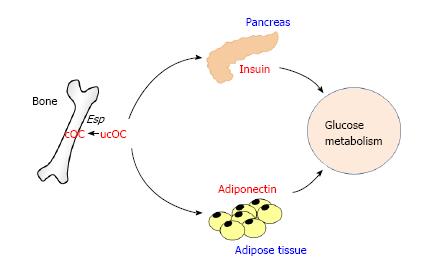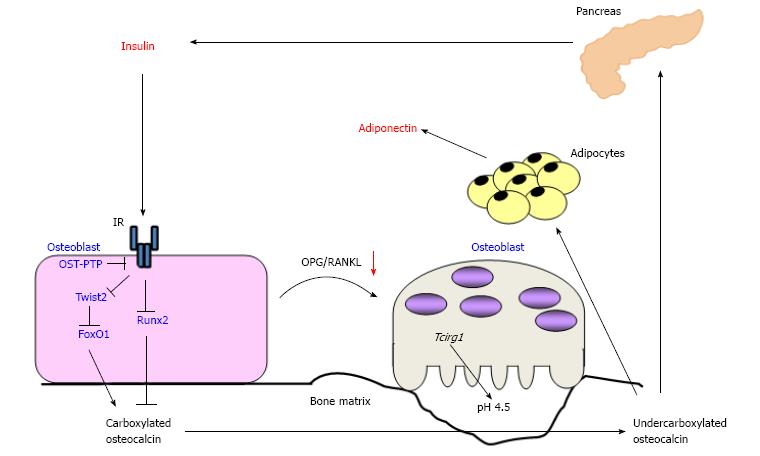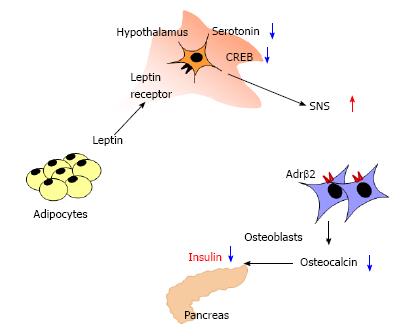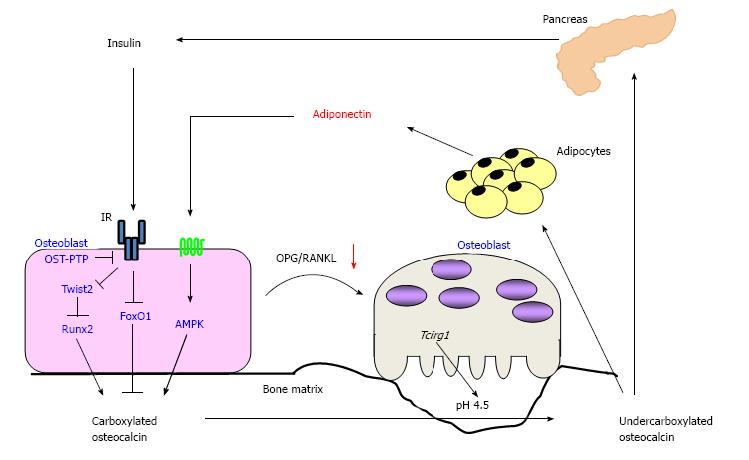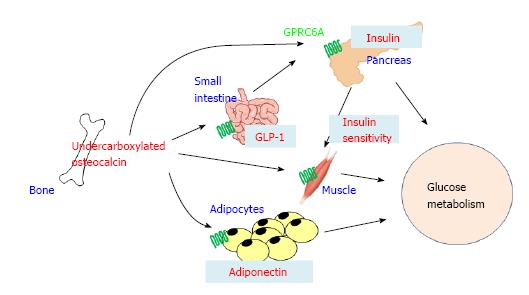Copyright
©The Author(s) 2015.
World J Diabetes. Dec 25, 2015; 6(18): 1345-1354
Published online Dec 25, 2015. doi: 10.4239/wjd.v6.i18.1345
Published online Dec 25, 2015. doi: 10.4239/wjd.v6.i18.1345
Figure 1 The effects of osteocalcin on pancreas and adipose tissue.
Undercarboxylated osteocalcin (ucOC) is an active form regulating glucose metabolism. Esp inactivate osteocalcin by carboxylating ucOC. ucOC increases insulin expression in pancreas and adiponectin expression in adipose tissue.
Figure 2 Schematic representation of the endocrine loops between bone and pancreas.
Insulin signaling stimulates the expression of osteocalcin and osteoblastic differentiation via inhibiting Twist2, an inhibitor of Runx2, as well as FoxO1, resulting in accumulation of carboxylated osteocalcin in bone matrix. Conversely, insulin activates osteoclasts and accelerate bone turnover via increasing the ratio of osteoprotegerin/receptor activator of nuclear factor kappa-B ligand. Activated osteoclasts decarboxylate bone matrix-embedded osteocalcin, and then undercarboxylated osteocalcin (ucOC) is released into the circulation. UcOC stimulates the expression of insulin in pancreas and of adiponectin in adipose tissue. OST-PTP: Osteotesticular protein tyrosine phosphatase; AMPK: AMP-activated protein kinase; OPG/RANKL: Osteoprotegerin/receptor activator of nuclear factor kappa-B ligand; IR: Insulin receptor.
Figure 3 Schematic representation of the regulation of insulin secretion by leptin.
Leptin directly inhibits insulin expression in pancreas. Leptin activates SNS by decreasing serotonin and cAMP response element binding protein in hypothalamus, and then enhanced SNS suppresses osteoblast differentiation and osteocalcin expression through the Adrβ2 in osteoblasts. Thus, leptin indirectly inhibits insulin expression via central nervous system and bone. SNS: Sympathetic nervous system.
Figure 4 Schematic representation of the endocrine loops between bone and pancreas, and adipose tissue.
Insulin signaling stimulates the expression of osteocalcin and osteoblastic differentiation via inhibiting Twist2, an inhibitor of Runx2, as well as FoxO1, resulting in accumulation of carboxylated osteocalcin in bone matrix. Adiponectin also stimulates osteocalcin expression and the differentiation of osteoblasts via AMP-activated protein kinase (AMPK) signaling pathway. Both insulin and adiponectin activate osteoclasts and accelerate bone turnover via increasing the ratio of RANKL/OPG. Activated osteoclasts decarboxylate bone matrix-embedded osteocalcin, and then undercarboxylated osteocalcin (ucOC) is released into the circulation. UcOC stimulates the expression of insulin in pancreas and of adiponectin in adipose tissue. OST-PTP: Osteotesticular protein tyrosine phosphatase; IR: Insulin resistance.
Figure 5 Schematic representation of the mechanisms regulating glucose metabolism by bone.
Undercarboxylated osteocalcin (ucOC) secreted from bone directly stimulates insulin secretion from pancreas and indirectly through increasing the secretion of glucagon-like peptide-1 (GLP-1) from small intestine. UcOC stimulates the expression of adiponectin in adipose tissue, resulting in increasing insulin sensitivity. UcOC also enhances insulin signaling in muscle. G-protein coupled receptor family C group 6 member A (GPRC6A) is a receptor for ucOC and expressed in pancreas β-cells, epithelial cells of small intestine, adipocytes, and myotubes.
- Citation: Kanazawa I. Osteocalcin as a hormone regulating glucose metabolism. World J Diabetes 2015; 6(18): 1345-1354
- URL: https://www.wjgnet.com/1948-9358/full/v6/i18/1345.htm
- DOI: https://dx.doi.org/10.4239/wjd.v6.i18.1345









